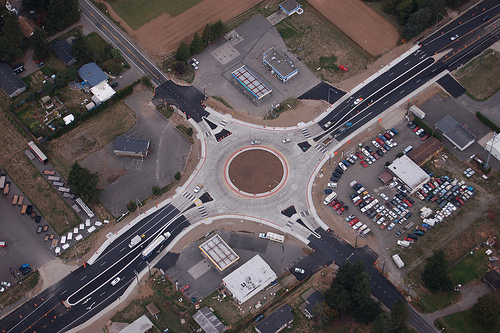By Shane Potter (Contributor) – Email
Print Edition: February 22, 2012
I know that many of you reading this are awesome drivers, so, at this point, you may disregard this article. This article is for the people who I am forced to share the road with each time I drive to UFV, for those who drive poorly and are unaware of the rules of the road – which I’m sure aren’t any of you.
I understand the foolishness of trying to explain driving tips to bad drivers; driving logic may be difficult for them to understand. How can I expect people to understand driving tips when I see drivers lose any sort of driving skill the second it starts raining? (The same people have difficulty with the concept of the fast lane/slow lane on the highway. I’ll break it down simply: if there are more than five car lengths between the cars in front of you and there are cars right behind you, move over.)
This article is specifically about roundabouts, so I’m going to take it upon myself to help everyone understand the rules of roundabouts. Before we start, though, let’s review some basic driving terminology so we are all on the same page.
Yield sign: This sign looks like an upside down rounded red triangle and means yield. You may think that the yield sign and the stop sign are friends, but trust me on this: they are not. Yield means to yield to other traffic; this is different from a stop sign, which requires you to actually stop. If there is no other traffic to yield to, guess what: you don’t have to stop.
Turn signals: Although turn signals are not installed on most cars in the lower mainland you can do a fun little test at home to see if your car has them. Look at your steering wheel it should have two levers on either side. Press down on the lever with arrows printed on it. Your car should make a strange clicking noise and there will be funny green arrows flashing in your dash. If this happens, congratulations! Your car is equipped with turn signals; use them.
If you find that the lever made your windshield wipers turn on, you’ve clicked the wrong lever, but don’t fret: you can use this newfound ability to improve your driving when it rains.
Perception: Perception is a basic awareness and understanding of your environment. This is an important part of driving. Perception is not something that comes with your car but something you’ve had the power to do all along, like Dorothy’s ability to return to Kansas.
With these terms in mind, let’s learn how to successfully use a roundabout.
A roundabout is simply a round intersection in which you drive counterclockwise. In the middle island of roundabouts in Abbotsford, you’ll find either an overpriced piece of art or a garden, which some politician decided to spend our tax dollars on.
When you approach the roundabout you’re going to notice our pal the yield sign. Listen to this very carefully; if there is no traffic in the lane you want to enter the roundabout. (You don’t have to stop, otherwise they would have put a stop sign there.)
If there is traffic in the roundabout, we use perception to determine when it is safe for us to enter the roundabout. Wait until there is enough room for you—and your car!—and then enter the roundabout counterclockwise. However, you do not need to wait until every car in Abbotsford is off the road before you enter the roundabout, and please keep this in mind when you are in front of me and I am late for class. Finally when you are ready to exit the roundabout, we use our turn signals to indicate to other drivers where we are going.
Easy and simple! Was that so bad?
Let’s conclude with some common mistakes. Do not stop in the roundabout to let other traffic in. Cars in the roundabout have right of way, if you stop you will cause an accident. The speed limit in the roundabout is not 5km/h. You can slow down to enter the roundabout, but you should maintain the normal flow of traffic. Do not cut off traffic that is already in the roundabout: that’s why there is a yield sign.
Now that we understand the basics of roundabouts get out there and tell others. Make bad roundabout driving a thing of the past.




